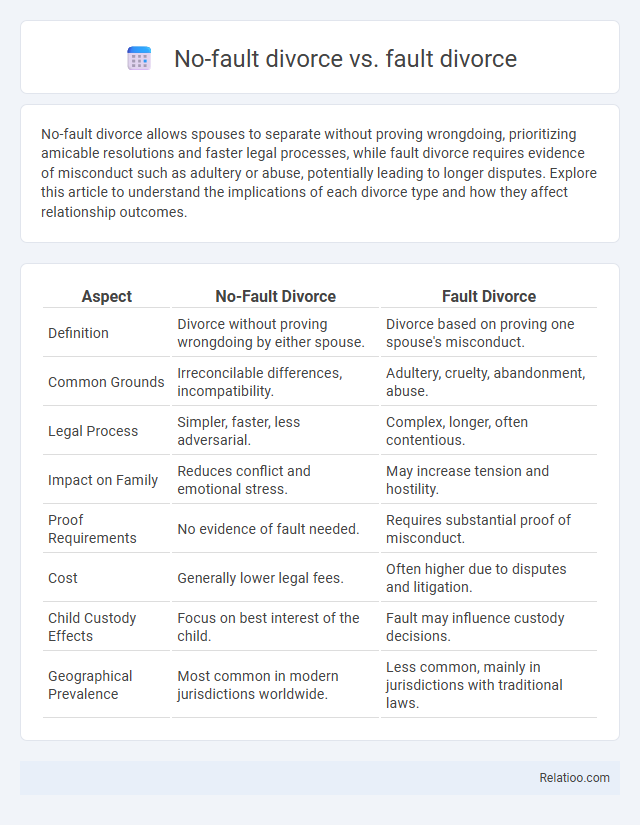No-fault divorce allows spouses to separate without proving wrongdoing, prioritizing amicable resolutions and faster legal processes, while fault divorce requires evidence of misconduct such as adultery or abuse, potentially leading to longer disputes. Explore this article to understand the implications of each divorce type and how they affect relationship outcomes.
Table of Comparison
| Aspect | No-Fault Divorce | Fault Divorce |
|---|---|---|
| Definition | Divorce without proving wrongdoing by either spouse. | Divorce based on proving one spouse's misconduct. |
| Common Grounds | Irreconcilable differences, incompatibility. | Adultery, cruelty, abandonment, abuse. |
| Legal Process | Simpler, faster, less adversarial. | Complex, longer, often contentious. |
| Impact on Family | Reduces conflict and emotional stress. | May increase tension and hostility. |
| Proof Requirements | No evidence of fault needed. | Requires substantial proof of misconduct. |
| Cost | Generally lower legal fees. | Often higher due to disputes and litigation. |
| Child Custody Effects | Focus on best interest of the child. | Fault may influence custody decisions. |
| Geographical Prevalence | Most common in modern jurisdictions worldwide. | Less common, mainly in jurisdictions with traditional laws. |
Introduction to Divorce Laws
Divorce laws vary significantly across jurisdictions, with no-fault divorce allowing couples to dissolve their marriage without proving wrongdoing, while fault divorce requires one party to establish the other's misconduct, such as adultery or abuse. No-fault divorce has become increasingly prevalent, streamlining legal processes and reducing conflict by eliminating the necessity to assign blame. Understanding the distinctions between these divorce types is crucial for navigating legal rights, property division, and child custody arrangements effectively.
What is No-Fault Divorce?
No-fault divorce allows you to end your marriage without proving wrongdoing by either spouse, simplifying the legal process and reducing conflict. In contrast, fault divorce requires one party to prove misconduct such as adultery or abuse, often leading to longer, more contentious proceedings. Understanding the benefits of no-fault divorce can help you choose a smoother path to legally dissolve your marriage.
What is Fault Divorce?
Fault divorce occurs when one spouse alleges that the other is responsible for the breakdown of the marriage due to misconduct such as adultery, abuse, abandonment, or cruelty. Unlike no-fault divorce, where neither party needs to prove wrongdoing, fault divorce requires evidence to support these allegations, which can impact decisions related to alimony, child custody, and property division. Understanding fault divorce is crucial as it can prolong legal proceedings and influence the outcome of the divorce settlement.
Key Differences Between No-Fault and Fault Divorce
No-fault divorce requires neither party to prove wrongdoing, simplifying the legal process by focusing on irreconcilable differences or mutual consent, which typically leads to faster resolutions and less conflict. Fault divorce demands that one spouse prove the other's misconduct, such as adultery or cruelty, making the proceedings more adversarial and often lengthier, involving substantial evidence and potential legal battles. Understanding these key differences helps Your choice align with your specific circumstances and desired divorce experience.
Grounds for Filing No-Fault Divorce
Grounds for filing no-fault divorce typically include irreconcilable differences or irretrievable breakdown of the marriage, which do not require proving wrongdoing by either spouse. In contrast, fault divorce necessitates specific allegations such as adultery, abandonment, cruelty, or imprisonment, making the process more adversarial and often lengthier. No-fault divorce streamlines legal proceedings by removing the burden of proof related to marital misconduct, facilitating a quicker and less contentious dissolution.
Grounds for Filing Fault Divorce
Fault divorce requires proving specific grounds such as adultery, cruelty, abandonment, or imprisonment, which directly impact the legal process and potential outcomes in your case. No-fault divorce, by contrast, does not require assigning blame and is based on irreconcilable differences or separation. Understanding the grounds for filing fault divorce helps you determine the best strategy for your divorce proceedings and any related settlements.
Legal Process: No-Fault vs. Fault Divorce
No-fault divorce allows couples to dissolve their marriage without proving wrongdoing, simplifying the legal process through mutual consent or irreconcilable differences. Fault divorce requires one spouse to prove the other's misconduct, such as adultery or abandonment, often resulting in longer, more contentious proceedings. Courts generally favor no-fault divorce for its efficiency, reduced conflict, and streamlined settlements on property division and child custody.
Impact on Asset Division and Alimony
No-fault divorce allows for asset division and alimony decisions based primarily on financial needs and contributions, without proving wrongdoing, often resulting in a more equitable settlement. Fault divorce requires proving misconduct like adultery or abuse, which can influence courts to award a larger share of assets or higher alimony to the non-offending spouse. Your choice between no-fault and fault divorce significantly impacts how assets are divided and whether alimony is granted, highlighting the importance of understanding state-specific laws and financial implications.
Emotional and Social Implications
No-fault divorce often results in less emotional turmoil and social stigma, allowing couples to separate amicably without assigning blame. Fault divorce can intensify emotional distress and social repercussions due to accusations of misconduct, which may affect family dynamics and community perceptions. Overall, the choice between no-fault and fault divorce significantly influences the psychological well-being of spouses and the stability of their social relationships.
Choosing the Right Divorce Option
Choosing the right divorce option depends on your unique circumstances, including emotional readiness and legal considerations. No-fault divorce simplifies the process by eliminating the need to prove wrongdoing, often leading to faster resolutions, while fault divorce requires evidence of misconduct such as adultery or abandonment, which can complicate proceedings. Understanding these distinctions helps you make an informed decision that best protects your interests and supports a smoother transition.

Infographic: No-fault divorce vs fault divorce
 relatioo.com
relatioo.com